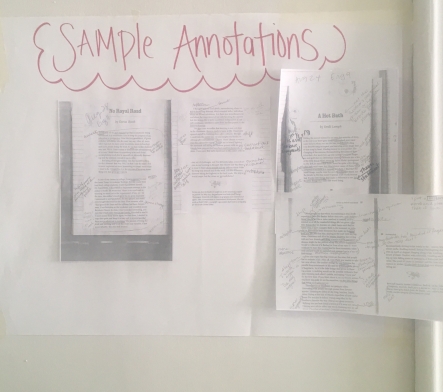When my students read, they think. There’s no question. But as a teacher, I struggle trying to figure out what they are thinking about, what they wonder, what resonates, what is confusing, and what they reject. Because reading is a mostly solitary activity, it sometimes feels impossible to tap into their brains so that I can “read” my students’s thoughts.
One of the strategies I employ is reflective essays. Other times, instead of in writing, students reflect verbally, either through conferring or through class and small group discussions. But sometimes that’s not enough. I need a window into their brains and hearts, and annotating text in a close reading can help to serve as that window.
My grade eleven students are deep in an informational text unit. They are in book clubs, and in addition, I’m regularly assigning the Kelly Gallagher Article of the Week for them to work on at home. Because these weekly assignments are with a short text, I feel comfortable asking them to demonstrate a close reading in a way that I’m not asking them to do with their longer texts.
I spent quite a bit of time teaching the nonfiction signposts from Reading Nonfiction, and instructed my students to notice and note when they recognized the different signposts.
But when I heard repeated individual students asking clarifying questions about annotations, I realized it was to spend another significant chunk of class time going over an article that students had read and annotated as homework. In the end, I think that investment of class time was worth it.
I projected it on the white board, explaining that while I had skimmed the article before assigning it (teacher life is real!), I hadn’t become familiar with it, and my annotations and think-aloud were authentic and unrehearsed.
I feel that with an authentic model think-aloud, the teacher should be mostly or entirely unfamiliar with the text that is being considered. We can’t be perfect in front of our students; how else will they understand that the struggle to learn and understand is messy, and that it is rare that a person understands difficult text during the first read? That it requires multi-draft reading in order to reach sincere understanding, the kind of understanding we have when we can not only discover main idea, but describe the nuance and ambiguity we often find in complex texts?
So I demonstrated by talking my way through the article, using a purple marker to show my initial confusion, and a red marker to demonstrate my second-draft reading.

I showed my students where I noticed the signposts, why I thought they were important to notice, and generally talked and walked them through my thinking. I made a point to show my confusion, highlighted words I wasn’t sure about, and I told them what I wondered.
I tried to show them that I don’t have all of the answers, but that I am willing to try to connect to text and find a deeper understanding of it.
I believe that teachers not only must model reading for pleasure – novels and narrative nonfiction should be a part of who we are – but we must also show the productive struggle that even mature readers often experience with shorter texts, and then show our students that the energy and effort that go into the process of understanding are worth it. And that most importantly, our students can do it too.
I think the moment of struggle is when when a lot of learning can happen. I don’t always time it perfectly; sometimes my students struggle too long, and sometimes I’m too eager to offer “the answer,” but I try to be aware of it. I think that’s all we teachers can do – pay attention to our students and act responsively.
Annotations start off sounding simple (just show your thinking!), but I think when students have different purposes for annotations in different classes and for different types of texts, they can get a bit confused. The purpose of demonstrating thinking is different from what might be the purpose in other classes, and this time, taking more time for more explicit teaching and modeling seemed to be the right call.


I was also reminded that I should update my “sample annotations” anchor chart with each unit, and be more explicit about how students can discover the purpose of annotations. I think I will ask my students if they don’t mind putting some of their own annotations up on our walls, as student work feels like a more authentic way to model the task. It is a good reminder that anchor charts should be dynamic instead of static. They aren’t meant to be handmade posters.
Annotations aren’t revolutionary, they aren’t high-tech, and they shouldn’t be used for every text. But they do have a place, and when done well, they can serve as a window or snapshot into how a student thinks and connects to text. I’ll keep teaching annotation and using this simple activity in my classroom. It’s one of the best ways I know for students to be transparent about their thinking.


Hi! Do you have copies of these handouts?
LikeLike
Hi! They are linked above – they are Kelly Gallagher’s article of the week. There are a few years archived as well as new ones posted weekly.
LikeLike